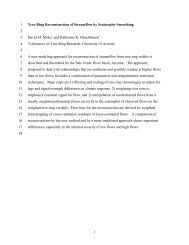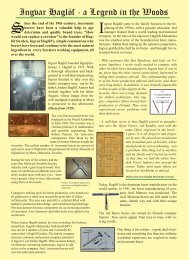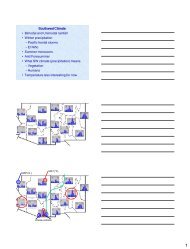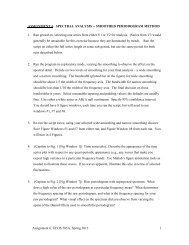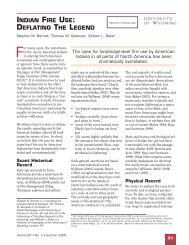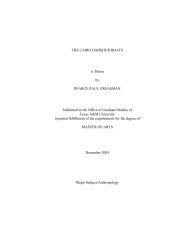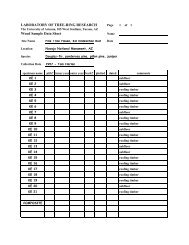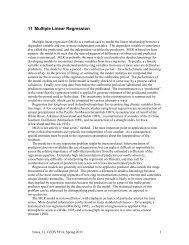[PDF] 6 Spectral Analysis -- Smoothed Periodogram Method
[PDF] 6 Spectral Analysis -- Smoothed Periodogram Method
[PDF] 6 Spectral Analysis -- Smoothed Periodogram Method
Create successful ePaper yourself
Turn your PDF publications into a flip-book with our unique Google optimized e-Paper software.
The variance of the estimator is proportional to the sum of squares of the filter weights. Thebandwidth for a given Daniell filter can therefore be computed as follows:1. Compute the sum of squares of the Daniell filter weights2. Compute the number of weights n of the evenly weighted moving average that haswthe same sum of squares as computed in (1)3. Compute the bandwidth as b w n f , where f is the spacing of the Fourierwfrequencies. (Note that if the series has been padded to length N ' , the spacing istaken as 1 / N ' )Differences in smoothness, stability and resolution are illustrated for spectra of the Wolfsunspot series in Figure 6.9. A lesser amount of smoothing of the raw periodogram yields thespectrum in Figure 6.9A. A greater amount of smoothing yields the spectrum in Figure 6.9B.The bandwidths indicate the differences in resolution of the two versions of the spectral. Bothversions clearly show the main spectral peak near 11 years, but the peak is narrower and muchhigher for the spectrum with less smoothing. On the other hand, the confidence interval aroundthe spectrum is much tighter for the spectrum with greater smoothing. Trial and errorcomputating and plotting of spectral with different degrees of smoothing for the smoothedperiodogram method is a analogous to the “window smoothing” approach described in lesson 4for the Blackman-Tukey method of spectral estimation.Note that the sunspot series also exhibits a spectral peak at near frequency 0.01 (wavelength100 years). This lower-frequency fluctuation is evident also in the time plot of the series (Figure6.2). Too much smoothing (e.g., Figure 6.9B) makes it impossible to resolve this peak from trend(peak at zero frequency).6.5 Testing for periodicityA peak in the estimated spectrum can be tested for significance by comparing the spectralestimate at a given frequency with the confidence interval for the estimate. Two considerationsfor the testing are:1. A significance test requires a null hypothesis. For the spectrum, the null hypothesis isthat the spectrum at the specified frequency is not different from some “null”spectrum, or null continuum. An earlier section described a white noise nullcontinuum, an autoregressive null continuum and a null continuum based on a greatlysmoothed raw periodogram. The null hypothesis is then that the estimated spectrum isno different than this underlying spectrum.2. The confidence bands developed above (equation 22) are not simultaneous. In otherwords, the bands should be used strictly to test for significance of a peak at a specifiedfrequency, and that frequency should be specified before running the spectral analysis.This approach can be contrasted with a “fishing expedition”, in which the spectrum isestimated and then browsed to identify “significant” peaks. Simultaneous confidencebands, which would be much wider than those given by equation 22, are needed if thespectrum is to be in such an exploratory mode to pick out significant peaks.To summarize, the test for periodicity begins with specification of a period or frequency ofinterest. Second, the spectrum and its confidence interval are estimated, possibly using awindow-closing procedure. Third, a null continuum is drawn so that the peaks in the spectrumcan be compared to a “null” spectrum without those peaks but with the same broad underlyingspectral shape. Finally, the peak is judged significant at 95% if the lower CI does not include thenull continuum.Notes_6, GEOS 585A, Spring 2013 13


![[PDF] 6 Spectral Analysis -- Smoothed Periodogram Method](https://img.yumpu.com/48640243/13/500x640/pdf-6-spectral-analysis-smoothed-periodogram-method.jpg)

